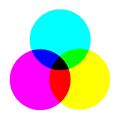Color: Difference between revisions
imported>Robert W King |
imported>Robert W King No edit summary |
||
| Line 10: | Line 10: | ||
There are primarly seven groups of wavelengths that when interpreted in different ways are capable of producing the billions of observable colors that we see. Those groups are represented by a familiar mnemonic device: Roy G Biv, which stands for Red, Orange, Yellow, Green, Blue, Indigo, Violet. | There are primarly seven groups of wavelengths that when interpreted in different ways are capable of producing the billions of observable colors that we see. Those groups are represented by a familiar mnemonic device: Roy G Biv, which stands for Red, Orange, Yellow, Green, Blue, Indigo, Violet. | ||
[[Image:Additive vector.jpg|right|thumb|The additive color model. Here, the wavelengths produced by red, green, and blue combine to produce white.]] | [[Image:Additive vector.jpg|right|thumb|120px|The additive color model. Here, the wavelengths produced by red, green, and blue combine to produce white.]] | ||
Even though all color is defined by the absorption of light in the eye, two different models exist for defining the application of color. The first is ''additive'' color, whereby red, blue, and green light can be overlapped to produce the spectrum; white light exists where they all intersect at the midpoint. This model is representative of the way color is produced by monitors, televisions, projectors, lamps, etc. The more colors that are produced using this method, the more wavelength frequencies that are present. In essence, we are seeing more light being reflected back to our eyes. | Even though all color is defined by the absorption of light in the eye, two different models exist for defining the application of color. The first is ''additive'' color, whereby red, blue, and green light can be overlapped to produce the spectrum; white light exists where they all intersect at the midpoint. This model is representative of the way color is produced by monitors, televisions, projectors, lamps, etc. The more colors that are produced using this method, the more wavelength frequencies that are present. In essence, we are seeing more light being reflected back to our eyes. | ||
[[Image:Subtractive vector.jpg|left|thumb|The subtractive color model. Note that Cyan, Magenta, and Yellow combine to form the three primary colors.]] | [[Image:Subtractive vector.jpg|left|thumb|120px|The subtractive color model. Note that Cyan, Magenta, and Yellow combine to form the three primary colors.]] | ||
The second model is ''subtractive'' color, which defines how we see color when it is physically applied to a media. The color that we might see when we use crayons on paper comes from the light which is ''not'' reflected back to us. When we mix different colors of paint, we are increasing the amount of wavelength frequencies absorbed, ''reducing'' the amount that is reflected back to us. | The second model is ''subtractive'' color, which defines how we see color when it is physically applied to a media. The color that we might see when we use crayons on paper comes from the light which is ''not'' reflected back to us. When we mix different colors of paint, we are increasing the amount of wavelength frequencies absorbed, ''reducing'' the amount that is reflected back to us. | ||
Revision as of 12:34, 13 June 2007
Color is the observation of light as it is reflected or absorbed by the human eye and processed by the brain. The actual distinction of colors occurs within the inner layer of the eye, the retina.
Inside the retina, four different kinds of light-sensitive receptors exist. The first are rods, which are responsible for general light absorption. The next three types are cones that absorb varied wavelengths. The length of the waves determines what kind of color is absorbed. Long wavelength absorbtion produces red colors; middle wavelengths produce greens; short wavelengths produce blues.
The capability for these cone receptors to absorb different wavelengths exists because of the pigments within them: a transmembrane protein called opsin which binds to the prosthetic group retinal, a type of Vitamin A. Rods employ a different kind of pigment called Rhodopsin, which is in the membrane of the outer section.
Rods are extremely sensitive to light. A single photon is enough to send signals to the brain.
The Spectrum
There are primarly seven groups of wavelengths that when interpreted in different ways are capable of producing the billions of observable colors that we see. Those groups are represented by a familiar mnemonic device: Roy G Biv, which stands for Red, Orange, Yellow, Green, Blue, Indigo, Violet.
Even though all color is defined by the absorption of light in the eye, two different models exist for defining the application of color. The first is additive color, whereby red, blue, and green light can be overlapped to produce the spectrum; white light exists where they all intersect at the midpoint. This model is representative of the way color is produced by monitors, televisions, projectors, lamps, etc. The more colors that are produced using this method, the more wavelength frequencies that are present. In essence, we are seeing more light being reflected back to our eyes.
The second model is subtractive color, which defines how we see color when it is physically applied to a media. The color that we might see when we use crayons on paper comes from the light which is not reflected back to us. When we mix different colors of paint, we are increasing the amount of wavelength frequencies absorbed, reducing the amount that is reflected back to us.
Despite these being two seperate systems, there is a common pool of terms that can be used to describe color.
Hue: Hue is what we used to describe the color that we see, either a red, or an orange, or purple.
Saturation: Saturation describes how much grey is in a color--its "purity".
Value (also Brightness): We use value to describe how bright or dark a color is; specifically, how much light or white is in a color.

